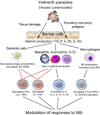Helminth-Tuberculosis Co-infection: An Immunologic Perspective
- PMID: 27501916
- PMCID: PMC5003706
- DOI: 10.1016/j.it.2016.07.005
Helminth-Tuberculosis Co-infection: An Immunologic Perspective
Abstract
Over 2 billion people worldwide are infected with helminths (worms). Similarly, infection with Mycobacterium tuberculosis (Mtb) occurs in over a third of the world's population, often with a great degree of geographical overlap with helminth infection. Interestingly, the responses induced by the extracellular helminths and those induced by the intracellular Mtb are often mutually antagonistic and, as a consequence, can result in impaired (or cross-regulated) host responses to either of the infecting pathogens. In this review, we outline the nature of the immune responses induced by infections with helminths and tuberculosis (TB) and then provide data from both experimental models and human studies that illustrate how the immune response engendered by helminth parasites modulates Mtb-specific responses in helminth-TB coinfection.
Published by Elsevier Ltd.
Figures


References
Publication types
MeSH terms
Grants and funding
LinkOut - more resources
Full Text Sources
Other Literature Sources
Medical

